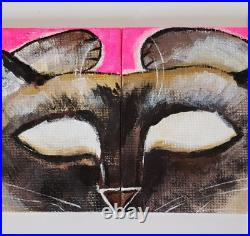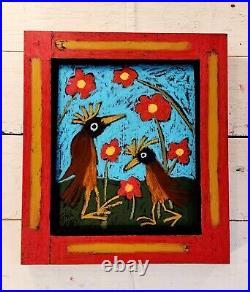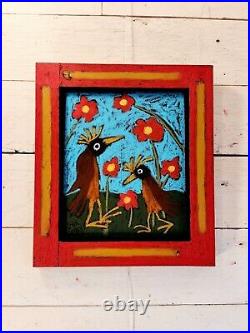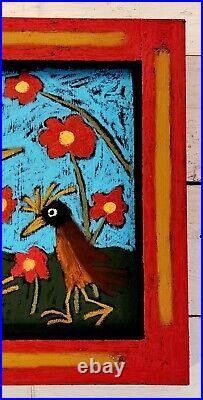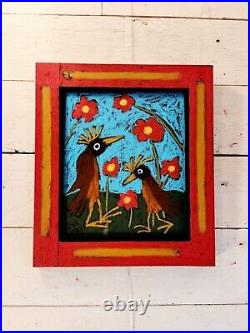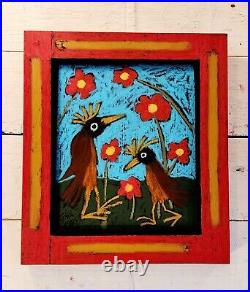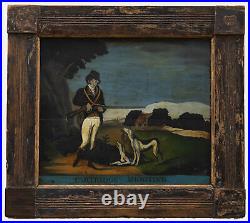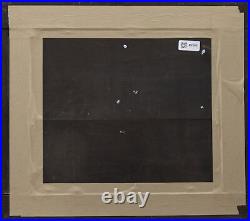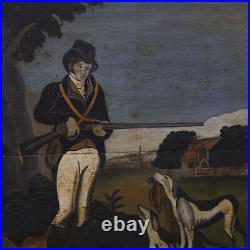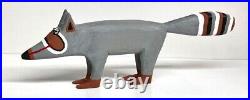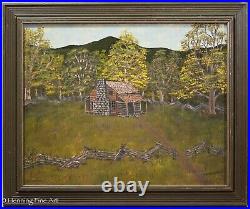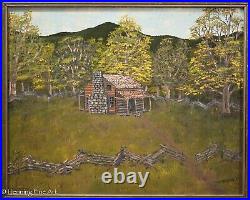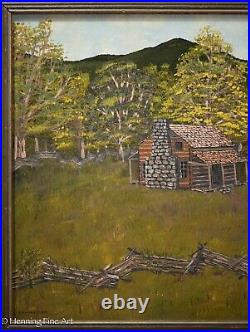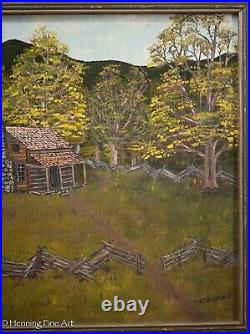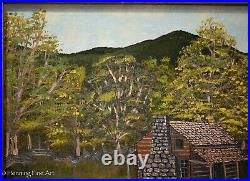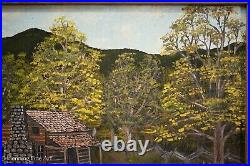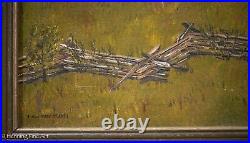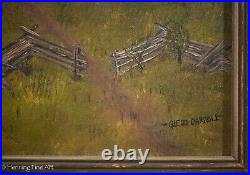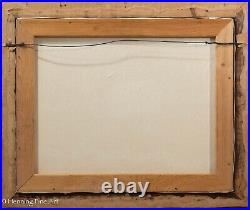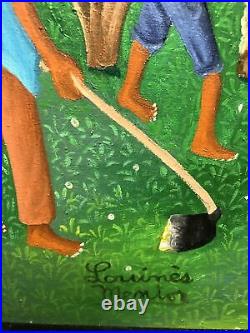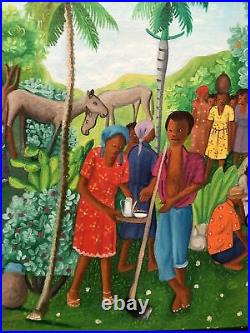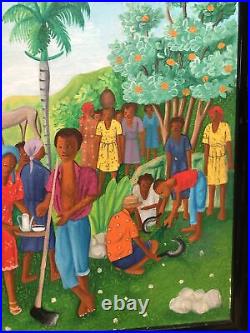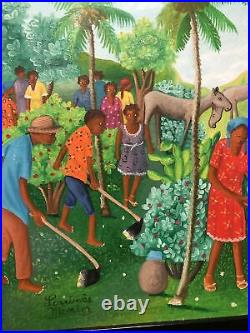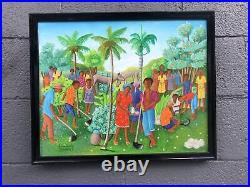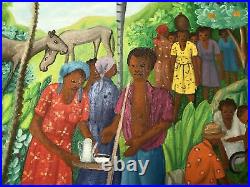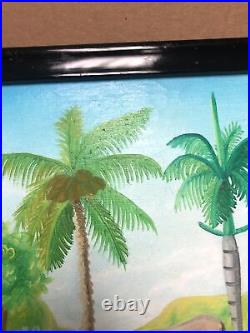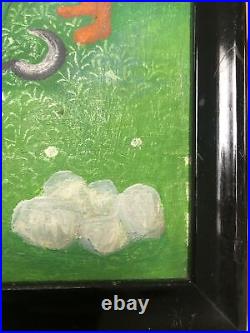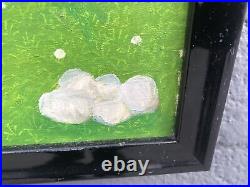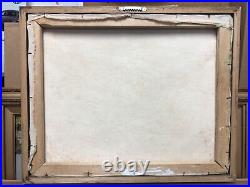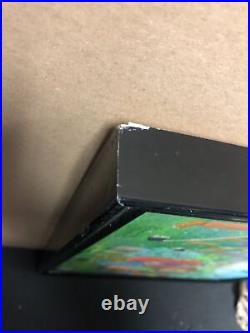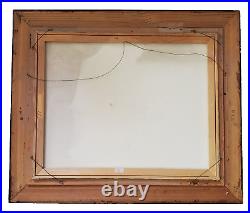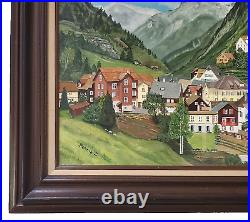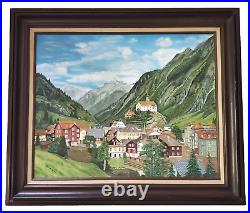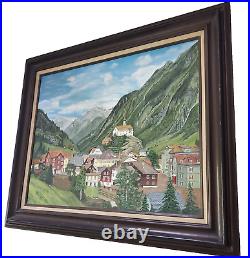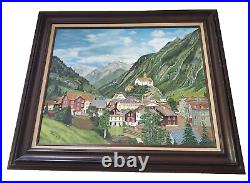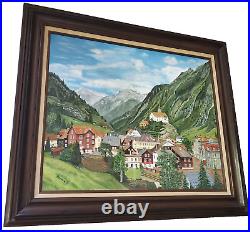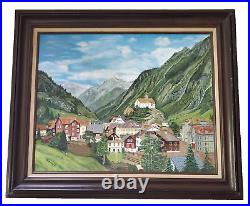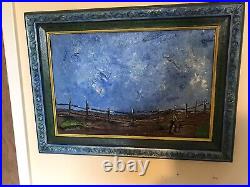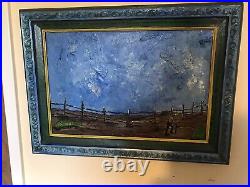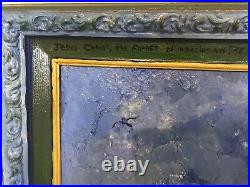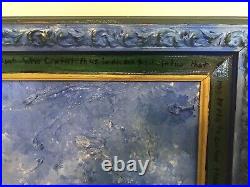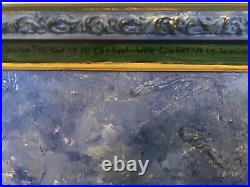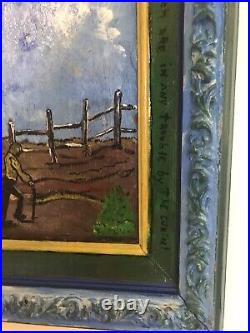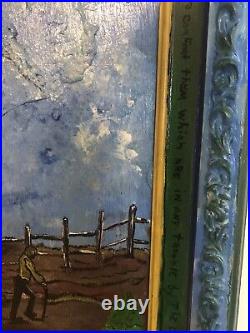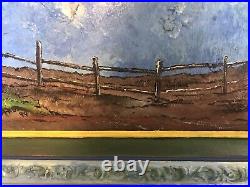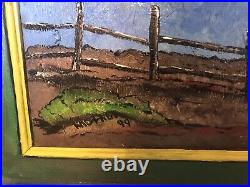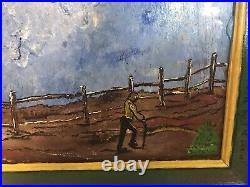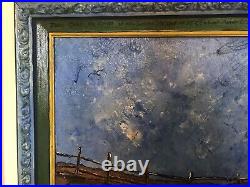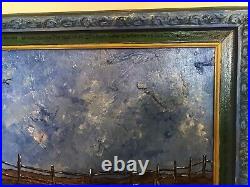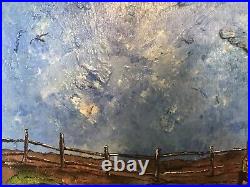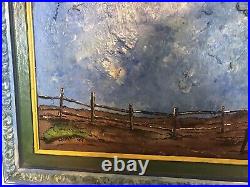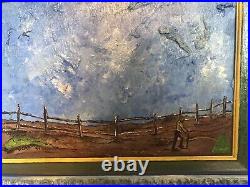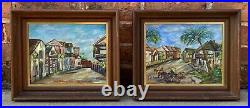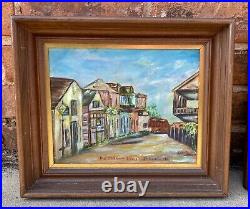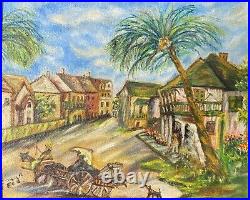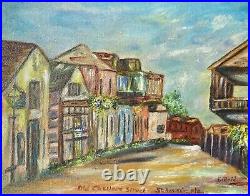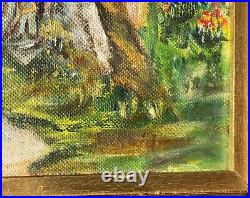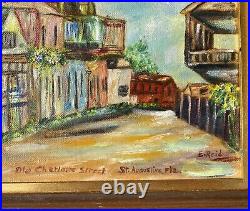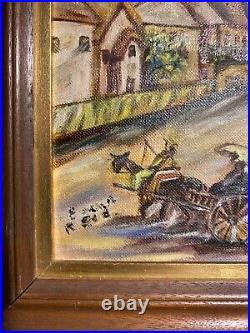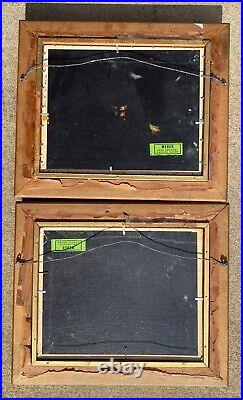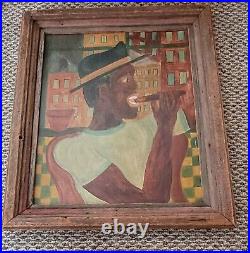


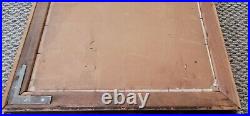

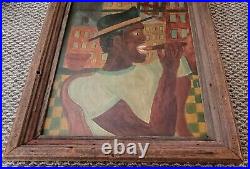


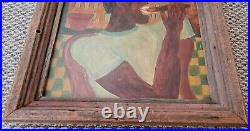

A (WHAT I SUSPECT TO BE A) CIRCA 1940’S… FOLK ART PAINTING OF AN AFRICAN AMERICAN MAN EATING WITH MANY BUILDINGS IN THE BACKGROUND. THE PAINTING IS NOT SIGNED AND IS FRAMED OVERALL APPROXIMATELY 29X25 INCHES WITH THE PAINTING ON BOARD MEASURING 24X20 INCHES. Folk art covers all forms of visual art made in the context of folk culture. Definitions vary, but generally the objects have practical utility of some kind, rather than being exclusively decorative. The makers of folk art are normally trained within a popular tradition, rather than in the fine art tradition of the culture. There is often overlap, or contested ground, [1] with naive art, but in traditional societies where ethnographic art is still made, that term is normally used instead of “folk art”. The types of object covered by the term vary considerably and in particular divergent categories of cultural production are comprehended by its usage in Europe, where the term originated, and in the United States, where it developed for the most part along very different lines. Folk arts are rooted in and reflective of the cultural life of a community. They encompass the body of expressive culture associated with the fields of folklore and cultural heritage. Tangible folk art includes objects which historically are crafted and used within a traditional community. Intangible folk arts include such forms as music, dance and narrative structures. Each of these arts, both tangible and intangible, was originally developed to address a practical purpose. Once this purpose has been lost or forgotten, there is no reason for further transmission unless the object or action has been imbued with meaning beyond its initial practicality. These vital and constantly reinvigorated artistic traditions are shaped by values and standards of excellence that are passed from generation to generation, most often within family and community, through demonstration, conversation, and practice. Characteristics of folk art objects. Owned by the community. Utility of the object. Aesthetics of the genre. Materials, forms, and crafts. Influence on mainstream art. Detail of 17th century calendar stick carved with national coat of arms, a common motif in Norwegian folk art. Main article: Concepts in folk art. Objects of folk art are a subset of material culture and include objects which are experienced through the senses, by seeing and touching. As with all material culture, these tangible objects can be handled, repeatedly re-experienced, and sometimes broken. They are considered works of art because of the skillful technical execution of an existing form and design; the skill might be seen in the precision of the form, the surface decoration or in the beauty of the finished product. [3] As a folk art, these objects share several characteristics that distinguish them from other artifacts of material culture. The object is created by a single artisan or team of artisans. The craftsmen and women work within an established cultural framework. They frequently have a recognizable style and method in crafting their pieces, allowing their products to be recognized and attributed to a single individual or workshop. This was originally articulated by Alois Riegl in his study of Volkskunst, Hausfleiss, und Hausindustrie, published in 1894. Stressed that the individual hand and intentions of the artist were significant, even in folk creativity. To be sure, the artist may have been obliged by group expectations to work within the norms of transmitted forms and conventions, but individual creativity – which implied personal aesthetic choices and technical virtuosity – saved received or inherited traditions from stagnating and permitted them to be renewed in each generation. [4] Individual innovation in the production process plays an important role in the continuance of these traditional forms. Many folk art traditions like quilting, ornamental picture framing, and decoy carving continue to thrive, while new forms constantly emerge. Contemporary outsider artists are frequently self-taught as their work is often developed in isolation or in small communities across the country. The Smithsonian American Art Museum houses over 70 such folk and self-taught artists; for example, Elito Circa, a famous and internationally recognized artist of Indigenouism, developed his own styles without professional training or guidance. The taka is a type of paper mache art native to Paete in the Philippines. All folk art objects are produced in a one-off production process. Only one object is made at a time, either by hand or in a combination of hand and machine methods; they are not mass-produced. As a result of this manual production, each individual piece is unique and can be differentiated from other objects of the same type. In his essay on “Folk Objects”, folklorist Simon Bronner references preindustrial modes of production, but folk art objects continue to be made as unique crafted pieces by skilled artisans. The notion of folk objects tends to emphasize the handmade over machine manufactured. Folk objects imply a mode of production common to preindustrial communal society where knowledge and skills were personal and traditional. [6] This does not mean that all folk art is old, it continues to be hand-crafted today in many regions around the world. The design and production of folk art is learned and taught informally or formally; folk artists are not self-taught. [citation needed] Folk art does not strive for individual expression. Instead, the concept of group art implies, indeed requires, that artists acquire their abilities, both manual and intellectual, at least in part from communication with others. The community has something, usually a great deal, to say about what passes for acceptable folk art. [7] Historically the training in a handicraft was done as apprenticeships with local craftsmen, such as the blacksmith or the stonemason. As the equipment and tools needed were no longer readily available in the community, these traditional crafts moved into technical schools or applied arts schools. The object is recognizable within its cultural framework as being of a known type. Similar objects can be found in the environment made by other individuals which resemble this object. Without exception, individual pieces of folk art will reference other works in the culture, even as they show exceptional individual execution in form or design. If antecedents cannot be found for this object, it might still be a piece of art but it is not folk art. While traditional society does not erase ego, it does focus and direct the choices that an individual can acceptably make. The well-socialized person will find the limits are not inhibiting but helpful. Where traditions are healthy the works of different artists are more similar than they are different; they are more uniform than personal. The known type of the object must be, or have originally been, utilitarian; it was created to serve some function in the daily life of the household or the community. This is the reason the design continues to be made. Since the form itself had function and purpose, it was duplicated over time in various locations by different individuals. A ground-breaking book on the history of art states that every man-made thing arises from a problem as a purposeful solution. “[9] Written by George Kubler and published in 1962, “The Shape of Time: Remarks on the History of Things goes on to describe an approach to historical change which places the history of objects and images in a larger continuum of time. It maintains that if the purpose of the form were purely decorative, then it would not be duplicated; instead the creator would have designed something new. However since the form itself was a known type with function and purpose, it continued to be copied over time by different individuals. 1978 First Indigenous Painting, mixed media with soy sauce, water and Tinting Color and enamel paint on plywood created by Elito “Amangpintor” Circa, Philippines, 1978. The object is recognized as being exceptional in the form and decorative motifs. Being part of the community, the craftsman is well aware of the community aesthetics, and how members of the local culture will respond to his work. He strives to create an object which matches their expectations, working within (mostly) unspoken cultural biases to confirm and strengthen them. [10] While the shared form indicates a shared culture, innovation allows the individual artisan to embody his own vision; it is a measure of how well he has been able to tease out the individual elements and manipulate them to form a new permutation within the tradition. For art to progress, its unity must be dismantled so that certain of its aspects can be freed for exploration, while others shrink from attention. [11] The creative tension between the traditional object and the craftsman becomes visible in these exceptional objects. This in turn allows us to ask new questions about creativity, innovation, and aesthetics. Folk art comes in many different shapes and sizes and forms. It uses the materials which are at hand in the locality and reproduces familiar shapes and forms. In order to gain an overview of the multitude of different folk art objects, the Smithsonian Center for Folklife and Cultural Heritage has compiled a page of storied objects that have been part of one of their annual folklife festivals. The list below includes a sampling of different materials, forms, and artisans involved in the production of everyday and folk art objects. Truck art in South Asia. Listed below are a wide-ranging assortment of labels for an eclectic group of art works. All of these genres are created outside of the institutional structures of the art world, they are not considered “fine art”. There is undoubtedly overlap between these labeled collections, such that an object might be listed under two or more labels. [2] Many of these groupings and individual objects might also resemble “folk art” in one aspect or another, without however meeting the defining characteristics listed above. As our understanding of art expands beyond the confines of the “fine arts”, each of these types needs to be included in the discussion. A folk art wall in Lincoln Park, Chicago. Folk artworks, styles and motifs have inspired various artists. For example, Pablo Picasso was inspired by African tribal sculptures and masks, while Natalia Goncharova and others were inspired by traditional Russian popular prints called luboks. In 1951, the artist, writer and curator Barbara Jones organised the exhibition Black Eyes and Lemonade at the Whitechapel Gallery in London as part of the Festival of Britain. This exhibition, along with her publication The Unsophisticated Arts, exhibited folk and mass-produced consumer objects alongside contemporary art in an early instance of the popularisation of pop art in Britain. The United Nations recognizes and supports cultural heritage around the world, [17] in particular UNESCO in partnership with the International Organization of Folk Art (IOV). [18] By supporting international exchanges of folk art groups as well as the organization of festivals and other cultural events, their goal is promote international understanding and world peace. In the United States, the National Endowment for the Arts works to promote greater understanding and sustainability of cultural heritage across the United States and around the world through research, education, and community engagement. As part of this, they identify and support NEA folk art fellows in quilting, ironwork, woodcarving, pottery, embroidery, basketry, weaving, along with other related traditional arts. The NEA guidelines define as criteria for this award a display of “authenticity, excellence, and significance within a particular tradition” for the artists selected. In 1966, the NEA’s first year of funding, support for national and regional folk festivals was identified as a priority with the first grant made in 1967 to the National Folk Festival Association. Folklife festivals are now celebrated around the world to encourage and support the education and community engagement of diverse ethnic communities. Mingei (Japanese folk art movement). Minhwa (Korean folk art). Mak Yong (Northern Malay Peninsular folk art dance). Mexican handcrafts and folk art. Joget (Wider Malay folk art dance). Folk arts of Karnataka (India). Folk Art and Ethnological Museum of Macedonia and Thrace. Folk Art Museum of Patras, Greece. Folk Art Society of America. IOV International Organization of Folk Art, in partnership with UNESCO. National Endowment for the Arts. CIOFF: International Council of Organizations of Folklore Festivals and Folk Arts. Pennsylvania Folklore: Woven Together TV Program on textile arts. American Folk Art Museum. Smithsonian American Art Museum. Folk Art Center and Guild, Asheville NC. Museum of International Folk Art. Abby Aldrich Rockefeller Folk Art Museum. “Folk and Self-Taught Art”. Retrieved 11 June 2020. “Outliers and American Vanguard Art”. National Gallery of Art. Goncharova Biography Archived 2009-07-20 at the Wayback Machine, Hatii, retrieved 19/2/2012. “Popular Art, Pop Art, and’the Boys who Turn out the Fine Arts'”. Pop art and design. Massey, Anne, 1956-, Seago, Alex. John William “Uncle Jack” Dey.





